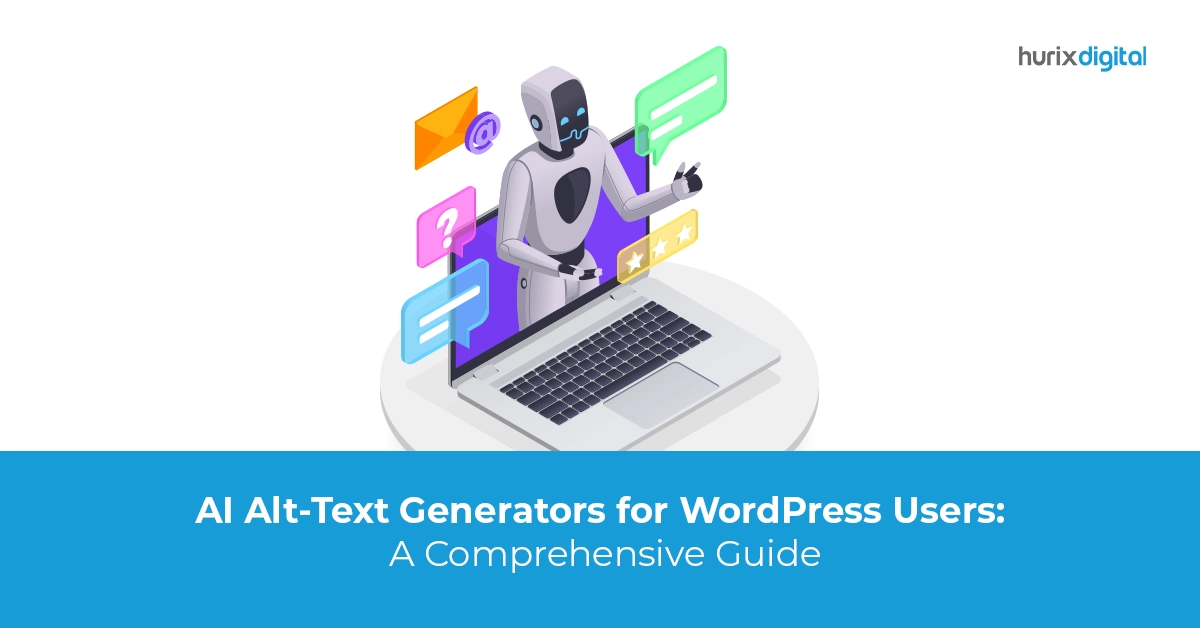A Comprehensive Guide on AI Alt-Text Generators for WordPress Users
In adherence to WCAG guidelines, incorporating Alt text for images on websites is essential for accessibility. However, creating meaningful Alt text can pose challenges and consume valuable time. This is where AI Alt Text generators come into play, offering a solution to streamline the process and efficiently generate descriptive text for images, ensuring both compliance and accessibility.
In this post, we’ll explore everything you need to know about Alt text generators and how they work and empower web developers and content creators. Let’s start!
Table of Contents:
- What is an Alt Text and Why is it Important for Your Website?
- What are the Challenges of Creating Meaningful Alt Texts?
- How Does an AI Alt Text Generator Work?
- How Do AI Alt Text Generators Empower Web Developers and Content Creators?
- Conclusion
What is an Alt Text and Why is it Important for Your Website?
An Alt text (alternative text), also known as an Alt tag or Alt attribute, is important for WordPress and any other web platform, mainly for accessibility and search engine optimization (SEO) reasons.
Here’s why Alt text is crucial in the context of WordPress:
1. Enhanced Web Accessibility
Alt text provides a text alternative to images on a website. This is crucial for people with visual impairments who use screen readers to navigate the web.
When an image has Alt text, the screen reader can read the description, allowing users with visual disabilities to understand the content and context of the image.
2. Better SEO (Search Engine Optimization)
Search engines like Google use Alt text to understand the content of images on a webpage. Including descriptive Alt text for images helps search engines index your content more accurately.
Alt text optimization can positively impact your website’s search engine rankings, making it more likely to appear in relevant search results.
3. Improved User Experience
Even for users without disabilities, Alt text can enhance user experience. When images fail to load due to slow internet connections or other issues, the Alt text is displayed instead, providing users with some context about the missing image.
4. Compliance with Web Standards
Following web standards and best practices is essential for building an inclusive and well-optimized website. Including Alt text aligns with web accessibility standards outlined in the Web Content Accessibility Guidelines (WCAG), ensuring your website is compliant and accessible to a broader audience.
You can add Alt text in WordPress when uploading or editing an image. Select the WordPress Media Library image and enter the relevant Alt text in the designated field. Many WordPress themes and plugins also provide options to optimize images for SEO, including Alt text optimization.
Also Read: How to Choose the Right AI Alt-Text Generator for Your Needs?
What are the Challenges of Creating Meaningful Alt Texts?
Website developers and content creators might find creating meaningful Alt text descriptions challenging for the following reasons:
1. Subjectivity
The interpretation of what is “meaningful” can vary from person to person. What one person finds descriptive, another might interpret differently. Striking the right balance between providing relevant information and avoiding unnecessary details can be challenging.
2. Conciseness
Alt texts should be concise yet informative. Finding the right words to convey the essence of an image briefly can be difficult, especially when dealing with complex or detailed visuals.
3. Creativity
Some images might be abstract or artistic, making it challenging to come up with a concise and meaningful description. Content creators might find it difficult to strike a balance between accuracy and creativity in such cases.
4. Technical Constraints
Lastly, character limits for Alt text may be imposed by certain platforms or content management systems. This constraint can make it difficult to provide comprehensive descriptions for complex images.
https://www.youtube.com/watch?v=pEbz4OylN0g
How Does an AI Alt Text Generator Work?
AI Alt Text generators typically operate using advanced algorithms, often utilizing a combination of computer vision and natural language processing (NLP) techniques.
This is how these systems make automated Alt text generation possible in a simplified manner:
Step 1: Image Recognition (Computer Vision)
The AI system analyzes the visual content of an image using computer vision algorithms. It identifies objects, people, scenes, and other elements within the image.
Next, the system extracts relevant features and characteristics of the objects, such as shapes, colors, and patterns.
Step 2: Context Understanding
The AI considers the context surrounding the image, including any adjacent text or captions. This helps the system understand the broader context of the image within the document or webpage.
Step 3: Natural Language Processing (NLP)
NLP algorithms process the extracted features and context to generate human-like text descriptions. The system may use pre-trained language models, such as those based on transformer architectures, to understand and generate natural language.
Step 4: Adaptability to Constraints
AI Alt Text generators are designed to adapt to character limits imposed by various platforms. They optimize generated descriptions to fit within these constraints while maintaining relevance and informativeness.
Step 5: User Customization and Feedback
Some AI Alt Text generators allow users, particularly content creators, to provide input or feedback. This collaborative approach ensures the generated descriptions align with the creator’s vision and preferences.
How Do AI Alt Text Generators Empower Web Developers and Content Creators?
AI Alt text generators are emerging as transformative allies for web developers and content creators because of their ability to seamlessly navigate the intricacies of context, optimize for technical constraints, and infuse creativity into concise AI-powered image descriptions.
Here’s more on how these tools are empowering web developers and content creators alike:
1. Precision and Context Awareness
AI Alt Text generators excel in understanding the context of an image and can provide precise descriptions tailored to the content at hand. By analyzing surrounding text, they ensure that the generated Alt text aligns seamlessly with the overall narrative, overcoming the hurdle of context dependence.
2. Conciseness and Creativity
These AI tools strike a balance between conciseness and creativity, generating concise yet engaging Alt text. By employing natural language processing algorithms, they capture the essence of an image in a manner that is both informative and captivating, even for abstract or artistic visuals.
3. Technical Constraints Management
AI Alt Text generators can adapt to various character limits imposed by platforms or content management systems. They optimize descriptions to fit within specified constraints, ensuring that the Alt text remains effective and compliant with technical requirements.
4. Diverse Audience Considerations
Recognizing the importance of inclusivity and improving WordPress content accessibility, AI Alt Text generators are designed to cater to diverse audiences. They aim to provide descriptions that are accessible and meaningful to users with varying levels of background knowledge and understanding.
5. Collaborative Integration
Many AI Alt Text generators allow for collaborative input, enabling content creators to refine and customize generated descriptions. This collaborative approach ensures that diverse perspectives contribute to the accuracy and inclusivity of the Alt text.
Also Read: AI-Powered Alt-Text Generators: A Game-Changer for SEO and Content Marketing
Conclusion
Alt text generators not only facilitate accessibility for visually impaired users but also contribute to a more inclusive and engaging online experience for all.
For web developers seeking to improve their alt texts, Equalsense is a powerful solution. This tool uses advanced artificial intelligence to analyze images and generate precise alt text in seconds quickly. Its AI algorithms are trained to avoid discriminatory language and offer concise yet descriptive alt text.
For further assistance on Alt text generation practices, head over to Hurix Digital today!

Associate VP of Technology, leads the design and development of innovative and accessible web solutions for publishing and eLearning clients. With over 20 years of experience in the ITES industry and a strong background in project management, automation, quality assurance, and offshore collaboration.









